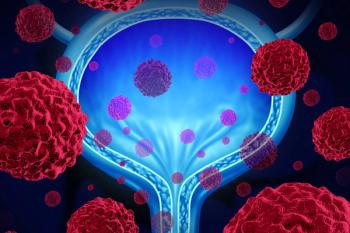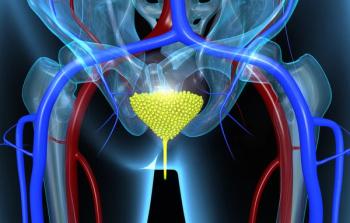
Heat Shock Protein Inhibitor May Benefit Bladder Cancer Patients
Advanced bladder cancer patients with poor prognosis appear to benefit from adding apatorsen 600 mg to first-line chemotherapy with gemcitabine/cisplatin.
Advanced bladder cancer patients with poor prognosis appear to benefit from adding apatorsen 600 mg to first-line chemotherapy with gemcitabine/cisplatin, according to the results of a randomized, double-blind, phase II trial (
“In this exploratory phase II randomized trial, a trend toward overall survival and progression-free survival benefit was seen in patients with poor-prognosis disease treated with first-line gemcitabine/cisplatin plus apatorsen 600 mg,” said Joaquim Bellmunt, MD, PhD, associate professor of medicine at Harvard Medical School.
Apatorsen is a novel second-generation antisense oligonucleotide designed to inhibit heat shock protein 27 (Hsp27), which is overexpressed in bladder cancer. “Inhibition of Hsp27 enhances apoptosis, inhibits epithelial-mesenchymal transition and metastasis, and sensitizes cancer cells to therapy, including hormone and chemotherapy,” Bellmunt said.
In the trial, 179 chemotherapy-naïve patients with advanced bladder cancer, with a median age of about 64 years, were randomized to gemcitabine/cisplatin plus apatorsen 600 mg (58 patients), gemcitabine/cisplatin plus apatorsen 1,000 mg (60 patients), or gemcitabine/cisplatin plus placebo (61 patients). Patients were stratified by Karnofsky performance status (KPS) and visceral disease. The primary endpoint was overall survival. A post-hoc analysis was performed to explore the hypothesis that Hsp27 inhibition might be relevant to overall survival in poor-prognosis disease.
The overall efficacy results show no difference between the groups, with a median overall survival of 15 months and progression-free survival of 7.5 months in all 3 groups.
“We created a statistical model for evaluating prognostic risk factors,” said Bellmunt. A multivariate analysis found four factors-KPS, liver metastases, alkaline phosphatase, and hemoglobin-had the most prognostic significance.
A median prognostic score dichotomized patients into poor- and good-prognosis groups. Patients with poor prognosis treated with gemcitabine/cisplatin plus apatorsen 600 mg had a greater reduction in risk of death (hazard ratio [HR] = 0.717) compared with patients with good prognosis (HR = 1.44).
“Although the control arm had a trend for more poor prognostic patients (32 patients) at baseline, similarly selected patients in the apatorsen 600 mg arm (22 patients) showed a survival benefit (HR = 0.72),” he said. The single most important poor prognostic feature was lower KPS. These patients who received apatorsen 600 mg showed the most survival benefit (HR = 0.50).
Overall, treatment was well tolerated. The most common grade 3 or higher adverse events were neutropenia, anemia, thrombocytopenia, and hypertension. The frequency of grade 3 or higher toxicities was around 90% in all 3 groups. Gemcitabine/cisplatin plus apatorsen 1,000 mg had a higher early discontinuation rate, mainly due to infusion reactions.
In conclusion, Bellmunt said, “Apatorsen may be impacting the intrinsic biology of patients with poor risk factors. It is important to identify patients who will benefit from apatorsen, using biomarkers.”
ASCO discussant Maria DeSantis of the University of Warwick, commented, “The rationale for this well-performed study is sound, using well-known prognostic factors. But there are small numbers in the poor prognostic group. We urgently need biomarkers to develop apatorsen in poor-prognosis patients.” She suggested testing the drug in combination with carboplatin plus gemcitabine or in non-platinum combinations.
Newsletter
Stay up to date on recent advances in the multidisciplinary approach to cancer.

















































































